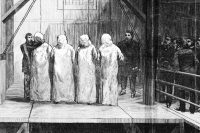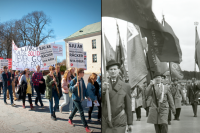
After the general election held in April 2011, the Finnish political life has faced its greatest changes since the Second World War. The massive surge of nationalist, anti-EU, social conservative party Perussuomalaiset (True Finns) and their rise to become the 3rd largest political force in the country, only a few thousands votes short from the Social Democrats (SDP), can historically be matched only by the initial rise of the labour movement, and by the Communist SKDL landslide victory after the war, when the party was released from ban.
Since the Finnish political culture favors coalition governments and is not based on party blocks as in Sweden, the initial talks were expected to start among the biggest parties. These parties included the centre-right National Coalition Party Kokoomus, which for the first time in Finnish political history emerged as the biggest political force in the Parliament, the SDP, which was able to improve its relative position even though the actual result, 19,1 percent of the total vote, was the 2nd worst in the party history, and the True Finns.
This axis, which some foreign commentators to the left also described as quite “unholy”, was however breached when Kokoomus and SDP were able to agree on a common policy concerning the change in Finnish position towards new European financial mechanisms, and possible new bail-out packages. The content of this package was unsuitable for the True Finns, who oppose Finnish participation to the euro rescue operations in any case.
After the True Finns notified their party was to remain in opposition, actual coalition talks started with 6 parties; Kokoomus, SDP, Left Alliance, Greens, Swedish People’s Party and Christian Democrats. The coalition talks were exceptionally long and hard on Finnish scale and were even breached once, when SDP and Left Alliance left the negotiations for a week, only to return when Green party council rejected, against the will of their party leadership and parliamentary group, their involvement in the right-wing government.
The “Six-pack” coalition was described in the media as a marriage made out of reason (or with force), as the only option to avoid new elections.
The end result concerning the new government program was in general considered as a victory for the SDP. All Social Democratic positions concerning the development of taxation (no rise to VAT, progressive element and rise in the capital income tax etc.), social benefits and education were adopted as part of the program. The change concerning the government’s cooperation relations with the trade union movement was also significant. Furtermore, since it’s establishment, the policies from the new government, bear witness to a continued strong Social Democratic presence.
***
So, what has this meant to the support of the SDP and rest of the left? Latest polls put Kokoomus in supreme lead with 24,4 percent; True Finns to the 2nd place with 21,4 percent; leaving SDP 3rd with 17,1 percent. A new low in the history of the SDP. The erosion of the Centre Party is continuing and they now poll only 13,1 percent.
What is especially significant is the demise of the leftist parties compared to the right. SDP and Left Alliance are now together as big as Kokoomus alone. This has never happened before. Greens, apart from many of their European counterparts, don’t count as a leftist party, but rather as a social liberal one.
The reasons behind the continuing trouble of the Finnish left, although it’s return to government, are various. Social Democracy in Finland is still suffering from an unclear identity. It has been widely considered that the SDP has lacked a strong vision for Finland after its last prime minister, Paavo Lipponen, who held the post 1995-2003. Under his leadership the SDP was by far the most dominant political force in the country and wielded considerable influence.
At this time Finnish Social Democracy could be described best as third-wayist, with focus on European integration and economic performance.
Mr. Lipponen’s time as the Party leader and prime minister is a debated topic within the party. It is unquestionable, that during governments he led, the Finnish economy was doing extremely well. Employment rose rapidly and Finland ranked to the top in various international comparisons, including education, competitiveness and even happiness. At the same time though, the social gaps between rich and poor were growing rapidly and the persisting unemployment remained relatively high.
This has been seen by some commentators as creating a lack of trust towards SDP as a modernizing force what comes to the social justice.
SDP is also suffering from a general atmosphere in society. The True Finn phenomena has less to do with immigration and Greek bail-outs, and more with the general demise of trust towards political institutions. Their strength derives from the juxtapositioning between the so-called “elite” and their “old parties” – and the “people”.
As the SDP is considered the main party behind the build-up of the Finnish welfare state – something the party also takes credit for – the general distrust towards politics, parties and institutions, hits hard at a party considered to be “establishment”.
What Finnish Social Democracy desperately needs are ways of communicating its renewing policies as a thorough political platform. At the moment the message is, although actual work done is in many ways impressive, rather messy.
This leaves room especially for Kokoomus to take credit from the accomplishments of the government. At the moment SDP fails to create a shared and compelling story where its policies are leading. SDP also needs more trust in itself. A party constantly on alert can’t focus its energy to renewal and ideological work.
The SDP brand must also be modernized. While living in an individualized era, thanks to the welfare state, the parties who want to catch people’s attention and interest have to offer compelling identities.
To vote for a party is a way to tell something about yourself too, its part of individual identity-building. In this regard, old collective identities of class or institutions aren’t so effective any more. Simplified; a green globe on my jacket makes me ethical, blue flower makes me dynamic and the red leaf makes, me, well, at the moment like trade unions and the welfare state.
But what does it tell about me as a person? If a movement lacks a clear positive response to this question, it is in trouble.
Esa Suominen, Administrative Director and Special Advisor to the President, Service Union United (PAM) – the second largest trade union in Finland.
Följ Dagens Arena på Facebook och Twitter, och prenumerera på vårt nyhetsbrev för att ta del av granskande journalistik, nyheter, opinion och fördjupning.


































